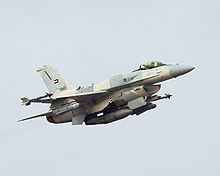 The F-16 Fighting Falcon is a compact, multirole fighter aircraft. It is highly maneuverable and has proven itself in air-to-air combat and air-to-surface attack. It provides a relatively low-cost, high-performance weapon system for the United States and allied nations.
The F-16 Fighting Falcon is a compact, multirole fighter aircraft. It is highly maneuverable and has proven itself in air-to-air combat and air-to-surface attack. It provides a relatively low-cost, high-performance weapon system for the United States and allied nations.In an air combat role, the F-16′s maneuverability and combat radius (distance it can fly to enter air combat, stay, fight and return) exceed that of all potential threat fighter aircraft. It can locate targets in all weather conditions and detect low flying aircrafts in radar ground clutter. In an air-to-surface role, the F-16 can fly more than 500 miles (860 kilometers), deliver its weapons with superior accuracy, defend itself against enemy aircraft, and return to its starting point. An all-weather capability allows it to accurately deliver ordnance during non-visual bombing conditions.
The F-16 is a high technology aircraft that requires pilot physical conditioning to perform up to nine G maneuvers. USAF F-16 multi-mission fighters were deployed to the Persian Gulf in 1991 in support of Operation Desert Storm, where more sorties were flown than with any other aircraft. These fighters were used to attack airfields, military production facilities, Scud missiles sites and a variety of other targets.
Originally conceived as a simple air-superiority day fighter, the aircraft was armed for that mission with a single six-barrel Vulcan 20-mm cannon and two Sidewinder missiles, one mounted at each wingtip. Over the years, however, the mission capability of the aircraft has been extended to include ground-attack and all-weather operations With full internal fuel, the aircraft can carry up to 12 000 pounds of external stores including various types of ordnance as well as fuel tanks.
The US Air Force took delivery of its last F-16 Fighting Falcon on March 18, 2005, the last of 2,231 F-16s produced for the Air Force. The first delivery was in 1978.
Tidak ada komentar:
Posting Komentar